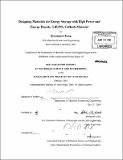| dc.contributor.advisor | Gerbrand Ceder. | en_US |
| dc.contributor.author | Kang, Byoungwoo | en_US |
| dc.contributor.other | Massachusetts Institute of Technology. Dept. of Materials Science and Engineering. | en_US |
| dc.date.accessioned | 2010-10-29T18:18:05Z | |
| dc.date.available | 2010-10-29T18:18:05Z | |
| dc.date.copyright | 2009 | en_US |
| dc.date.issued | 2010 | en_US |
| dc.identifier.uri | http://hdl.handle.net/1721.1/59707 | |
| dc.description | Thesis (Ph. D.)--Massachusetts Institute of Technology, Dept. of Materials Science and Engineering, February 2010. | en_US |
| dc.description | "February 2010." Cataloged from PDF version of thesis. | en_US |
| dc.description | Includes bibliographical references. | en_US |
| dc.description.abstract | LiFePO₄ has drawn a lot of attention as a cathode material in lithium rechargeable batteries because its structural and thermal stability, its inexpensive cost, and environmental friendliness meet the requirements of power sources for electric vehicles, except high power capability. Strategies to increase the rather sluggish rate performance of bulk LiFePO₄ have focused on improving electron transport in the bulk or at the surface of the material, or on reducing the path length over which the electron and Li* have to move by using nano-sized materials. However, recent evidence indicates LiFePO₄ is pure one dimensional lithium conductor. So, lithium transport is as important as electron transport. Strong anisotropic lithium diffusion results in limited transports of lithium ions in both the bulk and the surface. Reducing the particle size improves the transport of lithium ions in the bulk, and modification of the surface with a lithium-ion conducting material should enhance the transport of lithium ions on the surface. A poorly crystallized lithium phosphate phase on the surface of nanoscale LiFePO₄ is created by using proper off-stoichiometry (LiFeo.9Po.9504.3). The off-stoichiometric strategy leads to small particles less than 50 nm through grain growth restriction and a poorly crystallized lithium phosphate on the surface. The conducting surface phase can not only improve the transport of lithium ions on the surface but also facilitate the access of lithium ions to the surface by reducing anisotropic lithium diffusion on the surface induced by its amorphous nature. The off-stoichiometric material shows extremely high rate performance, achieving reasonable capacity even at 400C (9 s charge/discharge). In this thesis, the main finding is as follows: LiFePO₄ shows fast bulk kinetics and in itself does not limit the rate of charge and discharge. When bulk Li transport is very fast, the battery charging and discharging are limited by other factors such as the surface adsorption and surface transfer of lithium ions and the configuration of a cell. The off-stoichiometric strategy to improve surface transports addresses the right rate-limiting step and reveals the real capability of LiFePO₄. | en_US |
| dc.description.statementofresponsibility | by Byoungwoo Kang. | en_US |
| dc.format.extent | 278 p. | en_US |
| dc.language.iso | eng | en_US |
| dc.publisher | Massachusetts Institute of Technology | en_US |
| dc.rights | M.I.T. theses are protected by
copyright. They may be viewed from this source for any purpose, but
reproduction or distribution in any format is prohibited without written
permission. See provided URL for inquiries about permission. | en_US |
| dc.rights.uri | http://dspace.mit.edu/handle/1721.1/7582 | en_US |
| dc.subject | Materials Science and Engineering. | en_US |
| dc.title | Designing materials for energy storage with high power and energy density : LiFePO₄ cathode material | en_US |
| dc.title.alternative | LiFePO₄ cathode material | en_US |
| dc.type | Thesis | en_US |
| dc.description.degree | Ph.D. | en_US |
| dc.contributor.department | Massachusetts Institute of Technology. Department of Materials Science and Engineering | |
| dc.identifier.oclc | 668426205 | en_US |
